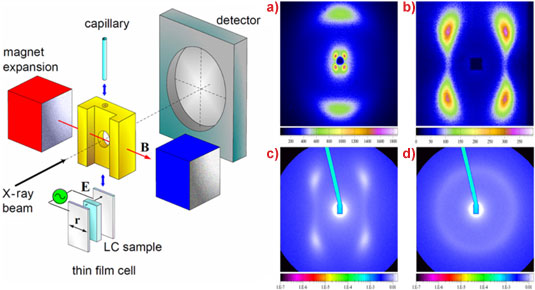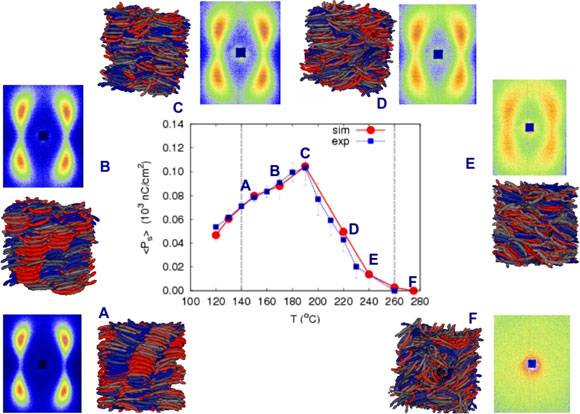- Home
- News
- Spotlight on Science
- A novel nematic...
A novel nematic liquid crystal phase with ferroelectric response
03-08-2009
Ferroelectric switching was observed for a nematic liquid crystal consisting of bent-core polar molecules. X-ray diffraction shows that this originates from the cooperative alignment of nanometric size polar and biaxial cybotactic groups present in the nematic phase. This discovery discloses the way toward ferroelectric fluids that can be aligned using a simple electric field.
Share
The elusive ferroelectric nematic liquid crystal phase promises spontaneous long range polar order coupled with fluidity and the ability to self-heal. The search for this phase is fuelled by fundamental and technological perspectives in the field of electro-optical devices with fast response to an electric field. Its properties are expected to be very different from those of conventional ferroelectric liquid crystals, namely more solid-like smectic phases, which are typically formed by chiral mesogens. The existence of such ferroelectric nematic liquid crystals is not forbidden from a theoretical point of view [1]. However, despite years of intensive experimental quest, no successful demonstration of ferroelectric nematic liquid crystals has yet been given in low molar mass thermotropic systems.
Here we present evidence of a ferroelectric response in the nematic phase of a bent-core mesogen, the 3,5-bis-{4-[4-(n-nonyloxy)benzoyloxy] phenyl}-1,2,4-oxadiazoles (9BPO in Figure 1) [2]. By combining repolarisation current measurements, electro-optical characterisation, synchrotron X-ray diffraction studies, and computer simulations, we demonstrate the ferroelectric switching response and show that the macroscopic bulk polarisation involves long-range orientational ordering of polar cybotactic clusters [3].
To investigate the nature of the phase organisation, we first performed X-ray diffraction measurements on a 9BPO sample in a glass capillary at various temperatures. The data collected (Figure 2a and 2b) show a pattern which is quite peculiar for an oriented nematic phase. The four symmetrically located diffuse spots in the small-angle X-ray scattering (SAXS) region hint at the presence of short-range smectic C-like ordering (cybotactic clusters) [4], while the position of the wide-angle crescents indicate that the bent-core mesogenic molecules align so that their long molecular axis (z in Figure 1c) is parallel to the horizontal magnetic field B. Analysis of the SAXS signal reveals the nanometric size of the cluster domains. In a second series of measurements on thin films a special-purpose setup allowed measurements at varying temperature under the simultaneous application of mutually orthogonal electric and magnetic fields (Figure 2). In the absence of the electric field E, we observed a SAXS four-spot pattern (Figure 2c) very similar to that obtained with the capillary samples aligned in the magnetic field, confirming an effective alignment of z parallel to r. When the electric field was applied, no changes were observed until the field strength exceeded a threshold value of a few V/μm, whereupon the four small-angle reflections turned into an isotropic diffuse ring (Figure 2d). Our results are consistent with a model according to which polar cybotactic clusters, under an applied field, reorient with their group dipole parallel to the field and the long molecular axes (hence the director n) randomly distributed around E.
 |
|
Figure 2. Drawing of the experimental X-ray diffraction setup (left) and diffraction patterns from the N phase at T=150°C with the thin film sample aligned by a magnetic (B) or electric (E) field applied either perpendicular to the beam direction or parallel to it (right): a) a capillary sample with B=0.5 T; b) a close-up of the small angle region in (a) showing the four symmetrically located diffuse spots as obtained at the beamline BM26; c) a thin (20 mm) liquid crystal film sandwiched between SiOx-covered glass plates aligning the director n in the liquid crystal cell parallel to r with B=0, E=0; and d) the same cell with B=0, and E= 7.5 V/μm, 500 Hz, obtained at beamline ID02. For all patterns, the magnetic field lies along the horizontal axis. After: O. Francescangeli et al.: Ferroelectric Response and Induced Biaxiality in the Nematic Phase of a Bent-Core Mesogen. Adv. Funct. Mater. 2009, DOI: 10.1002/adfm.200801865 Copyright Wiley-VCH Verlag GmbH & Co. KGaA. Reproduced with permission |
To verify the presence of polar ordering we measured the electric response and switching behaviour of the 9BPO nematic phase by means of the repolarisation current technique. The observed ferroelectric response indicates, differently from normal nematics, the existence of a switchable macroscopic bulk polarisation <Ps> in the direction of the applied electric field (reported in Figure 3 as a function of the temperature), and hence of polar ordering.
In order to understand the molecular mechanisms underlying the onset of polarisation, we performed Monte Carlo simulations using a coarse-grained rigid model where each bent-core mesogen is approximated with three Gay-Berne dipolar ellipsoids [5] (see Figure 1), whose optimised dimensions were derived from atomistic molecular dynamics trajectories, while the three point dipoles were estimated by fitting density functional theory moments. We found isotropic (I), nematic (N) and smectic C (SmC) phases, in good agreement with the experiments. Furthermore, the simulated N phase contains polar cybotactic clusters, in qualitative accord with the X-ray diffraction results.
We therefore simulated the effect of a static electric field E perpendicular to n, finding a large induced polarisation, as shown in Figure 3B (red circles), in excellent agreement with the repolarisation current measurements.
On the basis of the experimental and simulation results the switching mechanism of the 9BPO can be depicted as follows. The N phase consists of a conglomerate of nano-sized cybotactic clusters featuring short-range SmC-like ordering. Each group exhibits local and polar (i.e. ferroelectric) ordering due to the cooperative alignment of the molecules. Without electric field, the orientations of the domains are randomly distributed and, as a result, the macroscopic polarisation <Ps> averages out at zero. Applying E above a certain threshold triggers the transition of this non-polar phase into a polar nematic in which the cybotactic groups are on average aligned with their dipoles parallel to the applied field over macroscopic volumes. A net bulk polarisation is then induced and its direction can be reversed by changing the sign of E. This polar switching was confirmed by electro-optical measurements.
We believe that this represents significant progress towards the realisation of ferroelectric fluids that can be aligned on command by an electric field.
References
[1] J.W. Goodby, R. Blinc, N.A. Clar, S.T. Lagerwall, M.A. Osipov, S.A. Piking, T. Sakurai, K. Yoshino, B. Zeks, in: Ferroelectric Liquid Crystals, Gordon and Breach, Philadelphia, USA (1991).
[2] S.I. Torgova, T.A. Geivandova, O. Francescangeli, A. Strigazzi, Pramana 61, 239 (2003).
[3] A.G. Vanakaras, D.J. Photinos, J. Chem. Phys. 15, 154512 (2008).
[4] A. De Vries, Mol. Cryst. Liq. Cryst. 10, 219 (1970).
[5] S. Orlandi, R. Berardi, J. Stelzer, C. Zannoni, J. Chem. Phys. 124, 124907 (2006).
Principal publication and authors
O. Francescangeli (a), V. Stanic (a), S.I. Torgova (b), A. Strigazzi (c), N. Scaramuzza (d), C. Ferrero (e), I. P. Dolbnya (e), T.M. Weiss (e), R. Berardi (f), L. Muccioli (f), S. Orlandi (f), and C. Zannoni (f), Ferroelectric Response and Induced Biaxiality in the Nematic Phase of a Bent-Core Mesogen, Adv. Funct. Mater. 2009, DOI: 10.1002/adfm.200801865
(a) Dipartimento di Fisica e Ingegneria dei Materiali e del Territorio and CNISM, Università Politecnica delle Marche, Ancona (Italy)
(b) P.N. Lebedev Physical Institute of Russian Academy of Science, Moscow (Russia)
(c) Dipartimento di Fisica and CNISM, Politecnico di Torino (Italy)
(d) LiCryl (CNR- NFM), Dipartimento di Fisica, UNICAL, Rende (Italy)
(e) ESRF
(f) Dipartimento di Chimica Fisica e Inorganica and INSTM, Università di Bologna (Italy)
Top image: Simulation snapshot with arrows representing the electric dipoles of cybotactic groups. The inset shows the X-ray diffraction pattern of the nematic phase of 9BPO oriented by a static magnetic field.





